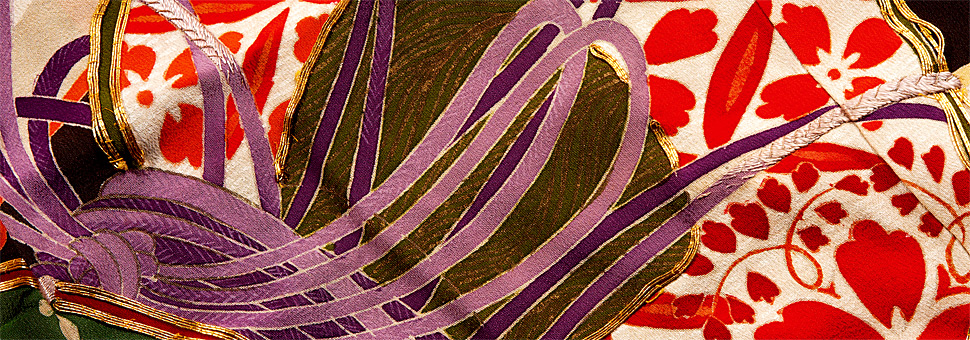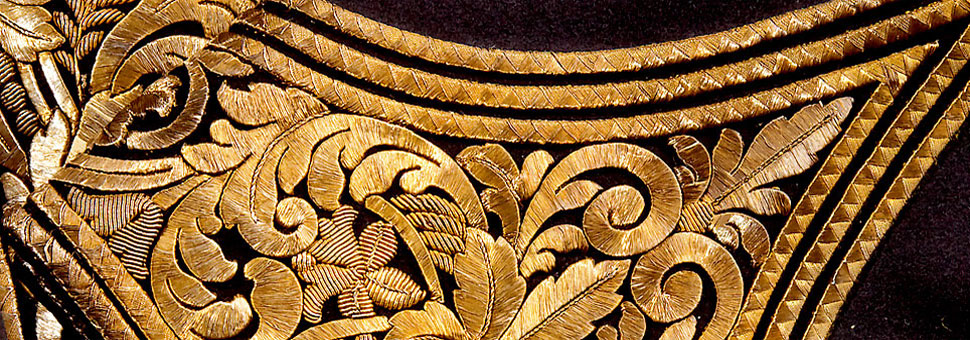This TRC blog was written by Catherine Nesmith, an educator and project manager based in Canada. She holds a PhD in Geography from Cambridge University, and is currently doing a Master's degree in Museum Education at the University of British Columbia. Textiles are a passion. She attended a workshop at the TRC in February 2025.
***
Textiles are an element of many museum collections. They represent the materiality of humanity and offer a window into understanding different cultures. This paper will address two areas of best practice for the effective use of textiles in museum education.

The first section argues that textiles can be an important cultural bridge and a key element in building collaboration between museums and communities, while supporting institutional decolonization goals. The second section focuses on object-based learning as a teaching pedagogy for textiles, recognizing the value of haptic learning, and the importance of incorporating reflective practice, and scaffolding. The paper concludes with a look at future directions and implications for museum education.
Craft, Community and Collaboration
Visitor-centered approaches have been prevalent in public museums since the 1990s, and recent scholarship calls for collaborative curatorial approaches that will serve diverse communities, and be adaptive in interpretive planning (Porter & Garcia, 2018; Spraggins, 2022). This demands shifting power dynamics, challenging the role of the museum as the authority, foregrounding decolonization, and developing an awareness of positionality (McManimon, 2021; Truels & Fisher, 2021). Bang et al. (2024) describe a Danish example of craft workshops with local Danes, migrant and refugee women, “… a museum curator would share textile items from the collection while a participant woman, invited as a speaker would also present textile items of her choice along with a personal story or a presentation of cultural traditions” (p.16). This is an example of sharing power and authority while retaining the valuable practice of drawing on historic museum textiles and curator expertise.
Bang et al. (2024) draw inspiration from ICOM’s (International Council of Museums) approach to engage visitors in dialogue-based co-creation and co-interpretation; the authors see the museum as a place where fashion and textiles can be a shared third language able to bridge intercultural encounters. They also draw on recent research in dress practices that focuses on the everyday, and individual fashion and creativity choices, connecting these to studies demonstrating the joy of being creative through textile craft, its healing and calming effects and the role of crafting in social engagement and networks. “Craft activities stimulate a deep satisfaction in learning a new technique, mastering it, and creating a good result. All this can take place without mastering a language, thus creating a non-verbal bond between speakers of different languages” (Bang et al., 2024, p.157).
Similarly, Robinson (2020) documents how a knitting evening at a local library in the UK became the venue for cross cultural relationships mediated by the focus on the material craft, and importantly supported by the ongoing presence of a low profile library staff facilitator. Both Bang et al. (2024) and Robinson (2020) represent a craft-based case of the museum (or library) behaving as ‘host’ for the incoming community (Rasmussen & DiCindio, 2023), providing an inviting and supportive environment for new forms of learning through knowledge exchange.
 The author at a TRC workshop, February 2025 (photograoh by Hannah Nesmith-Beck)Outside of these case-study settings, museums are reframing their presence to support diversity and craft culture heritage and exchange. Textile museums are assessing their collections in terms of Equity, Diversity and Inclusion (EDI) (Brucculieri et al., 2024). At the Textile Museum of Canada (TMC) they are “…undertaking sustained action to acknowledge and redress the ways colonialism and imperialism have shaped its collection” (p. 177). The TMC mandate includes making the collection available to the public, as well as providing school and public programming. In their research with three focus groups with diverse participants, one realm identified for change is active collection of objects, rather than passive acceptance of donations, as occurred in the past. Areas identified were African Canadian and Caribbean textiles. Indigenous textiles from Turtle Island with focus on artists in what is now known as Canada, contemporary textile art, and LGBTQ2S+ textiles. Focus group participants were clear that they want to be represented in the museum collections, and that they want the textiles to stay ‘living’. The vision is to accompany the textiles with rich contextual information and intangible heritage that will contribute to not only preserving but “…transmitting and evolving textile-related knowledge and practices” (p. 187).
The author at a TRC workshop, February 2025 (photograoh by Hannah Nesmith-Beck)Outside of these case-study settings, museums are reframing their presence to support diversity and craft culture heritage and exchange. Textile museums are assessing their collections in terms of Equity, Diversity and Inclusion (EDI) (Brucculieri et al., 2024). At the Textile Museum of Canada (TMC) they are “…undertaking sustained action to acknowledge and redress the ways colonialism and imperialism have shaped its collection” (p. 177). The TMC mandate includes making the collection available to the public, as well as providing school and public programming. In their research with three focus groups with diverse participants, one realm identified for change is active collection of objects, rather than passive acceptance of donations, as occurred in the past. Areas identified were African Canadian and Caribbean textiles. Indigenous textiles from Turtle Island with focus on artists in what is now known as Canada, contemporary textile art, and LGBTQ2S+ textiles. Focus group participants were clear that they want to be represented in the museum collections, and that they want the textiles to stay ‘living’. The vision is to accompany the textiles with rich contextual information and intangible heritage that will contribute to not only preserving but “…transmitting and evolving textile-related knowledge and practices” (p. 187).
Object-based Learning
Object-based learning is an approach focused on teaching through interactions with material culture, using concrete analysis of a physical object, then moving to more abstract and deeper analysis (Noy and Hancock, 2021). Objects can include specimens, artifacts, artworks, rare books, manuscripts, archives, and any material culture (Spraggins, 2022). Current museum discourse emphasizing accessibility and collaboration with the public has resulted in the ‘active collections’ paradigm, and new opportunities for touch in museums supported by a “… consensus in the literature around the pedagogical, therapeutic, and social gains of handling and touching museum objects” (Valente et al., 2024, p. 5). Incorporating touch can address accessibility issues for the vision-impaired and others, and build on object-based learning values. The presence in many museums of ‘handling collections’, also known as ‘working collections’, ‘teaching/educational collections, or ‘auxiliary collections’ (p.1), speaks clearly to the value of haptic encounters as teaching opportunities.
Reflective Practice and Scaffolding
Spraggins’ (2022, p. 33) review of object-based learning and academic Art museums concludes that multiple authors found students respond well to reflective prompts while working, hands-on, with authentic objects, and benefit from supported interpretation. This combination of structured reflective practice, and closely scaffolded learning is demonstrated in learning studies focused on textiles (Rodgers, 2015). Noy and Hancock (2021) provide detailed analysis of how they used molakana (embroidered blouses; Fig. 1) created by the Kuna people of Panama, as teaching tools to engage students with theories and debates on international development.
Although this case involved working with university students, it offers concrete methods that can be adapted to the museum. The course instructor worked closely with the museum curator to prepare the course materials and approach, an example of the need for educator/museum professional collaboration for effective programming (Kydd, 2007). Students encountered the textiles and development themes in a four stage process, beginning with a close analysis of colour, line, shape, and texture of the objects, followed by scaffolded exploration of cultural themes in the textiles, and how these relate to wider theories of social and economic development. Students found analyzing the small-scale and concrete example of molakana grounded their understanding of large-scale development issues.
One example from their method that would easily adapt to museum programming is a sketching activity in pairs, where one student describes the object in detail and the other, facing away, draws it. This builds visual literacy, and a vocabulary for describing material culture. Noy and Hancock (2021) argue that their framework can be adapted to multiple topics and materials and stress the importance of instructor/curator collaboration in planning, and ongoing reflective practice and scaffolding for students.
Rodgers (2015) led a research trip to Bali accompanied by three students to study ikat weaving in preparation for creating a museum exhibition focused on the relationships between ikat textiles, modern tourism markets, and Indonesian and international fashion wear. The trip included a factory visit in addition to seeing home-based production; the students became aware of the wider political economy issues and recognized the need to incorporate these into the exhibition. In Bali the team took ikat dyeing and weaving lessons and the students commented that they hadn’t appreciated the difficulty of the techniques and hadn’t understood how the natural dyes and the tying of the threads worked until they tried it themselves.
 Fig. 2. Reconstructed Bronze Age garments, including tablet woven belts. Rijksmuseum van Oudheden, February 19, 2025. Photograph by author.
Fig. 2. Reconstructed Bronze Age garments, including tablet woven belts. Rijksmuseum van Oudheden, February 19, 2025. Photograph by author.
In February in Leiden, the Netherlands, I attended a tablet weaving workshop with my daughter, which provides another small recent case-study of the value of haptic learning (Textile Research Centre, 2025). I am a life-long textile creator, however, for my adult daughter attending a craft-related workshop was new. The instructor, a textile archaeologist, began the workshop with a 20 minute slide presentation of tablet woven garments (mainly belts) in ancient and medieval imagery and from archaeological sites, supporting our learning with comprehensive scaffolding.
Examples of tablet weaving and yarns for our projects lay on the work tables. As we learned the weaving technique, the instructor shared more history of its use and patterns, ultimately revealing that she had designed and woven cloth, including tablet belts, based on archaeological evidence, that were now on display in an exhibition on the Bronze Age in a nearby branch of the Rijksmuseum (Rijksmuseum van Oudheden, 2025). After the workshop we visited the exhibition, which was a full circle moment to see the weaving we had learned in ‘authentic’ display with other Bronze Age reconstructed woven garments (see Fig. 2). Although I enjoyed the day very much, I could see the powerful impact the experience had on my daughter. She commented on how cool it was to learn the craft, how great to be doing that together with other people interested in the same thing, and how it really brought the significance of the practice into focus to see it in the museum exhibition. For me, this was a clear moment demonstrating the value - social, historical, educational, cultural - of contextualized learning through textile craft.
Conclusion
Future Directions
One direction for future exploration is the incorporation of virtual textiles or digitized textiles in museum learning. Influential museums like the Metropolitan Museum and the V&A in London have digitized textile collections that enable close study. However, other specialized resources like the Dutch Textile Trade Project ( Anderson and Kehoe, 2025) offering historical and descriptive data on 17th and 18th century traded textiles, also offer keys for developing the skill set for object-based learning with textiles. Supporting the continuing role of haptic encounters, Valente et al. (2024, p. 5) note that “…even the ongoing technological turn… is thought to be more fruitful if complemented with other sorts of multi-sensory engagement with the objects themselves”. Investigating ways that digital and object encounters can best complement each other will be central going forward (Lovlie & Waern, 2022).
Best Practices
This paper has explored two aspects of best practices for incorporating textiles into museum education. The first is to recognize that textiles can play the role of cross-cultural bridge in the museum setting. Its potential here will be best realized through a decolonizing institutional approach to textile programming through power sharing in collaborative textile endeavours, and in responsive adaptation of textile collections and acquisitions policies. The second best practice identified is object-based learning pedagogy with integrated reflective practice and scaffolding developed through educator/curator or teacher/museum educator collaboration. This method enables the textile to become a hands-on learning catalyst for culturally responsive contemporary museum education.
26 May 2025
References
- Anderson, C., & Kehoe, M. (2025). Dutch Textile Trade Project. Visual Textile Glossary. https://dutchtextiletrade.org/textiles/streep/
- Bang, A. L., Engholm, G., Lervad, S., Nosch, M.-L., & Skjold, E. (2024). Textile craft as empowerment: shared research and craft activities around textiles in museums in Denmark. Dress, 50(2), 151–173. https://doi.org/10.1080/03612112.2024.2370126
- Brucculieri, J., Krmpotich, C., & Shaughnessy, R. (2024). Pursuing equity, diversity, and inclusion in collection development: a Textile Museum of Canada case study. Dress, 50(2), 175–190. https://doi.org/10.1080/03612112.2024.2372203
- Kydd, G. (2007). Moving beyond the classroom: learning and the world of the art museum. In P. Villeneuve (Ed.), Periphery to Center-Art Museum Education in the 21st Century (pp. 117–122). National Art Education Association.
- Løvlie, A., & Waern, A. (Eds.). (2022). Hybrid Museum Experiences: Theory and Design. Amsterdam University Press.
- McManimon, S. K. (2021). Embedded research practices: practice as process, participatory method, and product in informal learning research. Journal of Museum Education, 46(2), 245–254. https://doi.org/10.1080/10598650.2021.1891757
- Noy, S., & Hancock, M. (2021). Teaching international development locally: using museum collections to ground students’ learning. Teaching Sociology, 49(1), 32–44. https://doi.org/10.1177/0092055X20966719
- Porter, J., & Garcia, S. S. (2018). Learning from doing: The evolution of a dialogue-based program about race. Journal of Museum Education, 43(4), 291–298. https://doi.org/10.1080/10598650.2018.1521135
- Rasmussen, B., & DiCindio, C. (2023). Gathering together with purpose: a new framework for museum education. In E. Wood (Ed.), A New Role for Museum Educators (pp. 263–270). Routledge.
- Rijksmuseum Van Oudheden. (2025, March). Bronze Age—Fires of Change [Online post]. Highlighted. https://www.rmo.nl/en/exhibitions/temporary-exhibitions/bronze-age/
- Robinson, K. (2020). Everyday multiculturalism in the public library: taking knitting together seriously. Sociology, 54(3), 556–572. https://doi.org/10.1177/0038038519899352
- Rodgers, S. (2015). Toward a pedagogy for faculty and student co-responsibility in curating college museum exhibitions. Arts and Humanities in Higher Education, 14(2), 150–165. https://doi.org/10.1177/1474022214554111
- Spraggins, E. (2022). Storied interactions: Narrative inquiry of collaborative object-based learning with Andean textiles. Florida State University.
- Textile Research Centre. (2025). Workshop tablet weaving with simple historical patterns, Wednesday 23 April 2025 [Workshop Announcement]. Textile Research Centre Leiden. https://www.trc-leiden.nl/trc/index.php/en/88-activities/wednesday-workshops/1475-worksop-tablet-weaving-basics-wednesday-14-june
- Truels, T., & Fisher, J. (2021). How we learned to question everything. Journal of Museum Education, 46(4), 519–530. https://doi.org/10.1080/10598650.2021.1982565
- Valente Cardoso, C., Arfvidsson, H., & Persson, M. (2024). “Handling collections”: potentials, challenges, and ongoing experiments at the Museum of World Culture, Sweden. International Journal of Heritage Studies, 1–14. https://doi.org/10.1080/13527258.2024.2443930.










